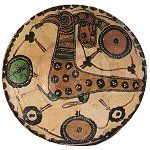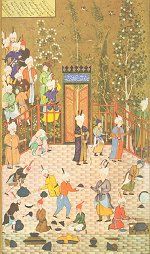Serving the Guest: A Sufi Cookbook
Essays | Recipes | Gallery
Many dishes are especially enjoyed throughout the modern world during 'Id al-Fitr, the Islamic New Year (Sheker Bayram in Turkish); 'Id al-Adha, the Feast of the Sacrifice (Kurban Bayram in Turkish); and Ramadan, the month when the Qur'an was first revealed to Muhammad, and during which healthy adult Muslims fast from dawn to dusk. It is said that the Prophet
This tradition certainly speaks first of spiritual generosity. The manifestation of Muhammad's example in the material world also includes a heightened awareness of the blessings that attend the sharing of meals.

After the practice of Muhammad, the Ramadan fast is usually broken simply, and as soon as possible, with dates and a drink of water, milk or juice, followed by salat (ritual prayer) and a full meal, often more elaborate than meals enjoyed at other times of year. There is a common human tendency to associate fasting with feasting; both are marked alterations in eating patterns. This tendency is intensified by the extended nature of the Ramadan fast, and Islam's emphasis on community and the sacred significance of hospitality. The result over time has been an intensified focus on food throughout the entire month, summed up by one cookbook's chapter title, "Ramadan, the month of self-discipline, meditation and prayers at daytime, and delicacies and festivals at night." The desirability of this custom is subject to debate. Muhammad al-Ghazali, in his discussion of fasting, recommended that those who are fasting eat moderately after breaking the fast, since there is no point in denying oneself a lavish meal only to make up for it again later. Contemporary Sufi teachers continue to regard habitual Ramadan indulgence as a subversion of the original purpose of the fast, destroying the spirit and ultimately making the experience more difficult to endure.
However, apart from any desire to indulge personally, there are practical reasons why large quantities of food are prepared during Ramadan. Should unexpected guests arrive, there should always be enough food to serve them a full meal; this is more likely to occur during Ramadan than at any other time of year. Also, during Ramadan it is often customary to send gifts of food to neighbors, relatives or close friends. This is a long-standing and widespread custom practiced by institutions and families alike. For example, between the 14th-19th centuries CE, the annual expenses of the shrine of Ali in Balkh included budgeted purchases of rice, sweets, and fruit for holiday distribution to the community.

Festive food is sometimes identified with a specific occasion, with certain dishes prepared only or usually for a particular day. In Turkey and the Balkans, the pudding Ashura is associated with the tenth of Muharram, to the extent that the day and the pudding share the same name. Harira, a thick soup that appears on the nightly iftar table during Ramadan in Morocco, is popular throughout the year; but its sweet companions, shebbakiyas, are generally prepared only during that month.
However, dishes once unique to Ramadan and other celebrations are now often served throughout the year. This is an outgrowth of increasing affluence, regular meat-eating, tourism and the rise of the modern "permanent feast" of the restaurant; and the year-round availability of many foods made possible by modern agriculture and food distribution networks. The extra-ordinary character of such dishes can be diminished through familiarity and disassociation from extra-ordinary occasions.

More often, holiday dishes are common ones that are always served on all or particular special occasions. Sewiyan is a vermicelli pudding that is the traditional Id al-Fitr morning meal in Pakistan and Trinidad, and is also enjoyed throughout the year. The South Asian puffed breads called puris are served year-round and are prepared for most holidays. In Egypt, fried fish is traditionally served the last night of Ramadan. Dishes may be "dressed up for company;" for instance, many Moroccan families will stock up extra olives, dried fruits and nuts to enrich their usual tagines (stews) during Ramadan. In a similar manner, an ordinary Iranian legume soup is enriched for Ramadan with dried fruits. The primary feature of the Ramadan table is not so much the uniqueness of the dishes, but their richness and variety.
The Muslim calendar is a lunar calendar, and its rotation through the solar agricultural year has made it impractical for strictly seasonal dishes to acquire permanence in association with Muslim holidays. (The one exception is No Ruz, the celebration of the vernal equinox which originated before the advent of Islam and is not primarily a religious holiday; it is, however, celebrated by millions of Muslims and over time has acquired an association as the birthday of Ali.) Therefore, many dishes for feasts of the Islamic calendar are prepared with dairy foods and meat, available throughout the year; and with pantry food, suited for long-term storage — dried legumes, rice, grains and flour, dried herbs and spices, nuts and seeds, onions and garlic, vegetable and fruit pastes, dried fruits, sugar and honey, and flavored sugar syrups.

Many festive foods are labor-intensive, some requiring preparation over several days. This results in part from the quantities in which festive foods are customarily prepared, and their often elaborate character. Traditionally, cooking for feasts has been a community or extended family endeavor, not the sole responsibility of a single individual (as is often the case in contemporary European and North American kitchens). The time and attention invested in the preparation of such foods becomes a part of their essential value. Repetitive and time-consuming tasks provide opportunities for dhikr, prayer and silence — practices appropriate for everyday cooking, as well.
from Serving the Guest: A Sufi Cookbook
Copyright © 1999, 2000 by Kathleen Seidel
Sources of previously published material by other authors used by permission, and print sources for images, may be found at http://www.superluminal.com/cookbook.
